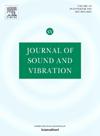三维水声定向源传播的半解析解
IF 4.9
2区 工程技术
Q1 ACOUSTICS
引用次数: 0
摘要
本文提出了在绝热法向模态框架下水声定向源三维传播的半解析解。利用夫琅和费远场近似和泰勒级数展开式简化了复杂源定向辐射的源强度积分,由绝热模模型提供的双求和表达式推导出了该解。通过与Pekeris波导中定向源的二维法模代码的比较,验证了导出的解决方案。另外两个例子突出了该解决方案在复杂工程问题中的有效性,包括移动内波条件下的定向传播和长岛湾附近船只的水下辐射噪声。该方法的一个关键优势在于其半解析公式,将声源指向性融入三维水声传播的过程减少到单个传播模型运行。即使在全三维情况下,当垂直模态系数的横向特征函数耦合时,如果方向源项发生变化,代表辐射条件的Dirichlet-to-Neumann算子也可以被存储和重用。这提高了计算效率,降低了数值成本。此外,该方法的全角度传播能力确保了对复杂光源的详细特征的准确描述。本文章由计算机程序翻译,如有差异,请以英文原文为准。
Semi-analytical solution for three-dimensional underwater acoustic propagation from a directional source
This article presents a semi-analytical solution for 3D underwater acoustic propagation from a directional source within the framework of adiabatic normal modes. The solution is derived from a double-summation expression provided by the adiabatic mode model using the Fraunhofer far-field approximation and Taylor series expansions to simplify the source-strength integral for directional radiation from a complex source. The derived solution is validated through comparisons with a 2D normal mode code for a directional source in a Pekeris waveguide. Two additional examples highlight the solution’s effectiveness in complex engineering problems, including directional propagation under moving internal wave conditions and underwater radiated noise from a vessel near Long Island Sound. A key advantage of this method lies in its semi-analytical formulation, which reduces the process of incorporating source directivity into 3D underwater acoustic propagation to a single propagation model run. Even in fully 3D scenarios, when the transverse eigenfunctions of vertical modal coefficients are coupled, the Dirichlet-to-Neumann operator representing the radiation condition can be stored and reused if the directional source term changes. This improves computational efficiency and reduces numerical costs. Furthermore, the method’s full-angle propagation capability ensures an accurate description of the detailed characteristics of complex sources.
求助全文
通过发布文献求助,成功后即可免费获取论文全文。
去求助
来源期刊

Journal of Sound and Vibration
工程技术-工程:机械
CiteScore
9.10
自引率
10.60%
发文量
551
审稿时长
69 days
期刊介绍:
The Journal of Sound and Vibration (JSV) is an independent journal devoted to the prompt publication of original papers, both theoretical and experimental, that provide new information on any aspect of sound or vibration. There is an emphasis on fundamental work that has potential for practical application.
JSV was founded and operates on the premise that the subject of sound and vibration requires a journal that publishes papers of a high technical standard across the various subdisciplines, thus facilitating awareness of techniques and discoveries in one area that may be applicable in others.
 求助内容:
求助内容: 应助结果提醒方式:
应助结果提醒方式:


